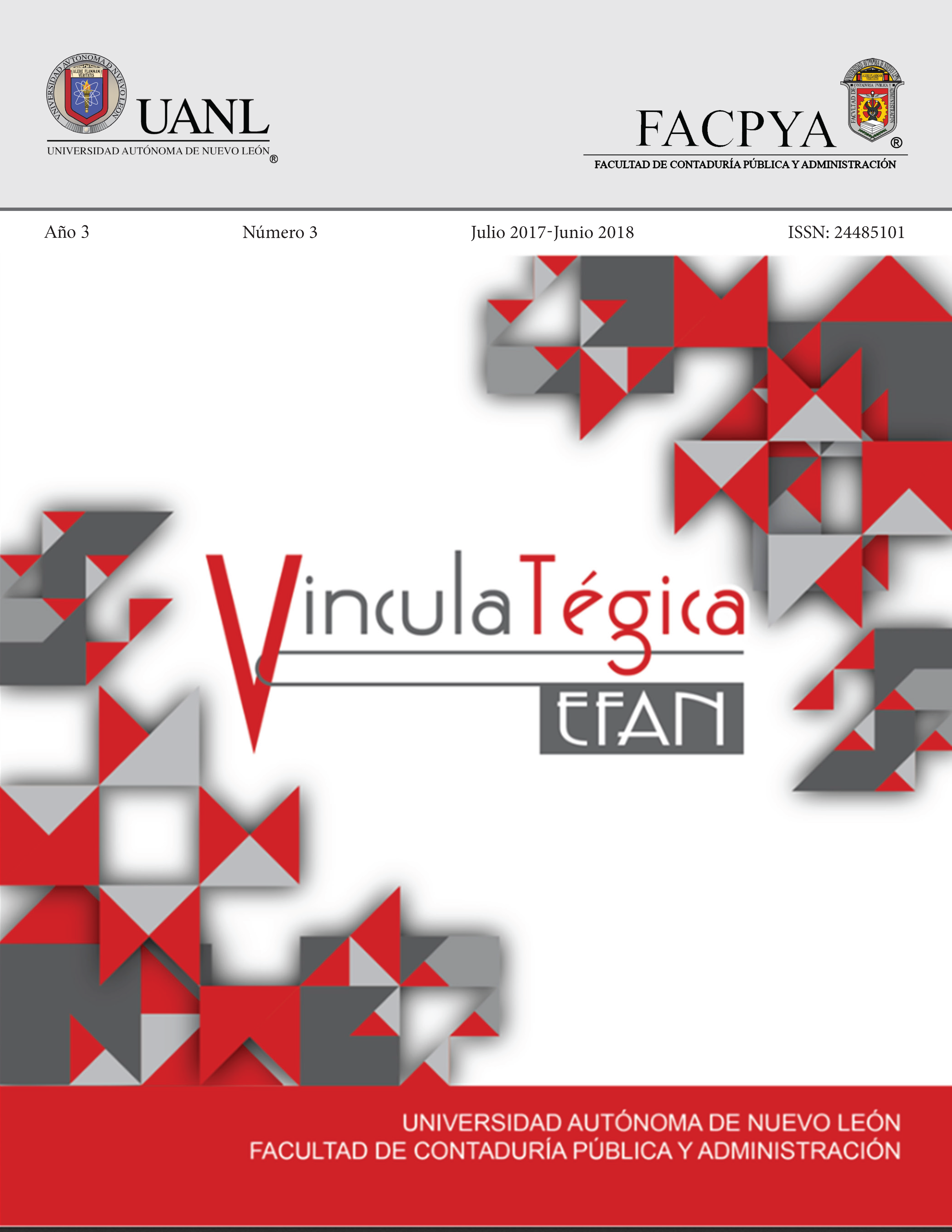La Cultura Organizacional y la Innovación como base del Rendimiento en empresas Familiares de Aguascalientes. Estudio múltiple de casos.
DOI:
https://doi.org/10.29105/vtga3.3-1076Keywords:
Organizational culture, innovation, performanceAbstract
Small and medium-sized enterprises (SMEs) have been an object of many investigators’ studies and represent a very important role in the economy of the country, not only in México, but worldwide; However, there are few studies that exist on family businesses in México and examine the organizational culture and the innovation performance of the family business. The objective of this research is to know the influence of organizational culture with innovation and performance in the family SMEs from the city of Aguascalientes; Results can be how organizational culture affects the innovative aspect and the performance of companies.
Downloads
References
Barney, J. B. (1991). Firm resources and sustained competitive advantage. Journal of Management, 17 (1), 99-120. DOI: https://doi.org/10.1177/014920639101700108
Belausteguigoitia Rius, (2010), Empresas familiares: su dinámica`, equilibrio y consolidación (2a. ed.) México: Mc Graw Hill.
Cameron, K. and Quinn, R. (1999). Diagnosing an changing organizational culture. based on the competing values framework. San Francisco: Prentice Hall Series in Organizational Deve- lopement.
Craig, J., & Lindsay, J.N. (2002). Incorporating the family dynamic into the entrepreneurship process. Journal of Small Business and Enterprise Development, 9(4), 416–30. http://dx.doi.org/10.1108/14626000210450586 DOI: https://doi.org/10.1108/14626000210450586
Cuervo, G. A. (1993). El papel de la empresa en la competitividad. Papeles de Economia Espanola, 56, 363-377
Cuevas, H. (2016). La influencia de la Innovación y la tecnología en la competitividad de las PYMES manufactureras del estado de Aguascalientes. Aguascalientes. Tesis Universidad Autónoma de Aguascalientes.
Esparza, J. L., y García, D. (2011). La cultura de las empresas familiares turísticas mexicanas y su influencia en la gestión estratégica. Cuadernos De Administración (01203592), 23(42), 295-313
Galvez, E., García, D. (2011) Cultura Organizacional y Rendimiento de las MIPYES de mediana y alta tecnología: un estudio empírico en Cali, Colombia. Cuadernos de Administración, (01203592), 23(42), 125-145.
Gallo, M. A. (1998). La sucesión en la empresa familiar. Caja de Ahorros y Pensiones de Barcelona. Barcelona.
Gatrell, J.; Jenkins, H. and Tucker, J. (2001). Family values in family business. En G. Corbetta and D. Montemerlo (Eds.), The role of family in family business, 12th. Milano: Annual FBN World Conference, Rome. EGEA S.p.A. FBN.
Grant, R. (1991). The Resource-Based Theory of competitive advantage: Implications for strategic formulation. California Management Review. pp 114-135. DOI: https://doi.org/10.2307/41166664
Goode, W. & Hatt, P. (1976). Métodos de la investigación social. México,Trillas.
Habbershon, T.G., Williams, M., & MacMillan, I.C. (2003). A unified systems perspective of family firms performance. Journal of Business Venturing, 18, 451-465. http://dx.doi.org/10.1016/S0883-9026(03)00053-3 DOI: https://doi.org/10.1016/S0883-9026(03)00053-3
Hall, B. (2011). Innovation and Productivity. NBER WP, No 17178. Cambridge, MA: NBER.
http://dx.doi.org/10.3386/w17178 DOI: https://doi.org/10.3386/w17178
Hernández, P. J. A., Gallarzo, M., & Espinoza, M. J. D. J. (2011). Desarrollo organizacional. México: Pearson Educación
Maldonado Guzmán, G., Martínez Serna, M., García Pérez deLema, D.; Aguilera Enríquez, L.; González Adame, M. (2010). La influencia de las TICS en el rendimiento de la PyME de Aguascalientes. Aguascalientes: Revista Investigación y Ciencia Número 47, (57-65).
Neely, A., Adams, C., and Kennerley, M., (2002). The performance prism: the scorecard for measuring and managing stakeholder relationship. London: Prentice Hall
OECD y EUROSTAT. (2005). Manual de Oslo. Noruega: Organización para la Cooperación y Desarrollo Económico y Oficina de Estadística de las Comunidades Europeas.
Peters, T.; Waterman, R., 1984. En busca de la excelencia: experiencias de las empresas mejor gerenciadas de los Estados Unidos, Bogotá, Norma.
Quinn, R. y Rohrbaugh, J. (1983) A spatial model of effectiveness criteria: towards a competing values approach to organizational analysis: Management Science, 29, 363-377. DOI: https://doi.org/10.1287/mnsc.29.3.363
Rubio, A., y Aragón, A. (2006). Competitividad y recursos estratégicos en las PYMES, Revista de Empresa, pp. 32-47.
Sabater, R.; Ruíz, J. y Carrasco, A. J. (2003). Caracterización de la cultura organizacional en la empresa familiar. Working paper, Universidad de Murcia
Vargas, J. G. (2007). La Culturocracia organizacional en México. España: B - EUMED.
Villareal, M 366 . D., Martínez, P. (2009). Caracterización de la cultura empresarial en la PyME fabricante de muebles de la Ciudad de Durango. Conciencia Tecnológica (37), 13-19.
Villareal, M. D., Villareal, F. M., Gurrola, C. (2009).La cultura empresarial como factor explicativo de la integración en las pequeñas y medianas empresas fabricantes de muebles. Hitos de Ciencias Económico Administrativas (46), 17-26.
Vivanco, F. J. S. (2014). La cultura organizacional y la medición del rendimiento de las micro y pequeñas empresas. México: Revista Iberoamericana de ciencias.
Wen-Chia, H. (2007). Using the competing values framework to compare leaders´ oles, managerial activities/behaviours, and organizational culture between generations of family business in Taiwan. Tesis Doctoral, School of Graduate Studies, University of the Incarnate Word.
Yescas, M. (2008). La cultura organizacional y el desempeño de los negocios de artesanía. Tesis de Maestría, CIIDIR Unidad Oaxaca, México: Instituto Politécnico Nacional
Yin, R. K. (1989). Case Study Research: Design and Methods. California: Sage Publications Inc.Thousand Oaks.
Downloads
Published
How to Cite
Issue
Section
License

This work is licensed under a Creative Commons Attribution 4.0 International License.
a). Authors keep copyright and give the journal the right of the first publication of the work under a Creative Commons attribution license. This license allows others to share the work as long as original authorship and initial publication in this journal is acknowledged.
b). Authors may make other independent and additional contractual agreements for the non-exclusive distribution of the version of the article published in this journal (e.g., include it in an institutional repository or publish it in a book) as long as they clearly indicate that the work was published for the first time in this journal.







